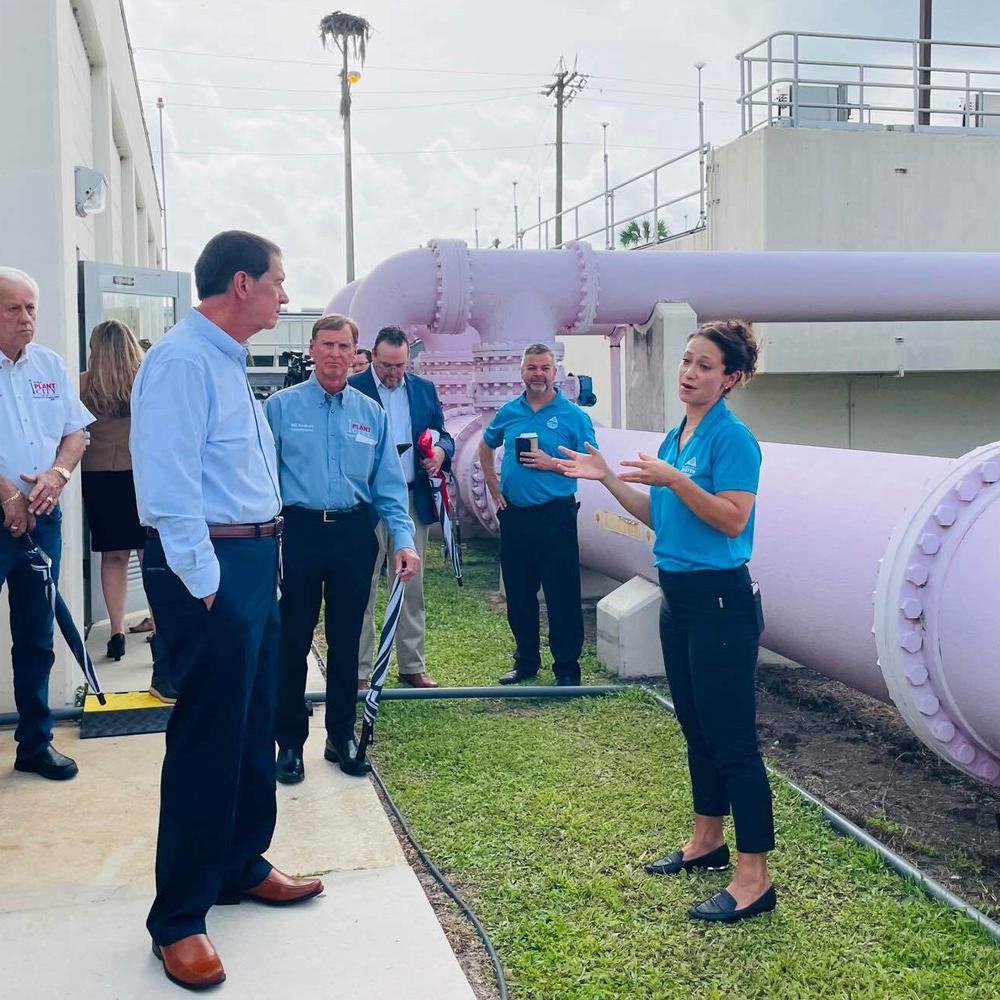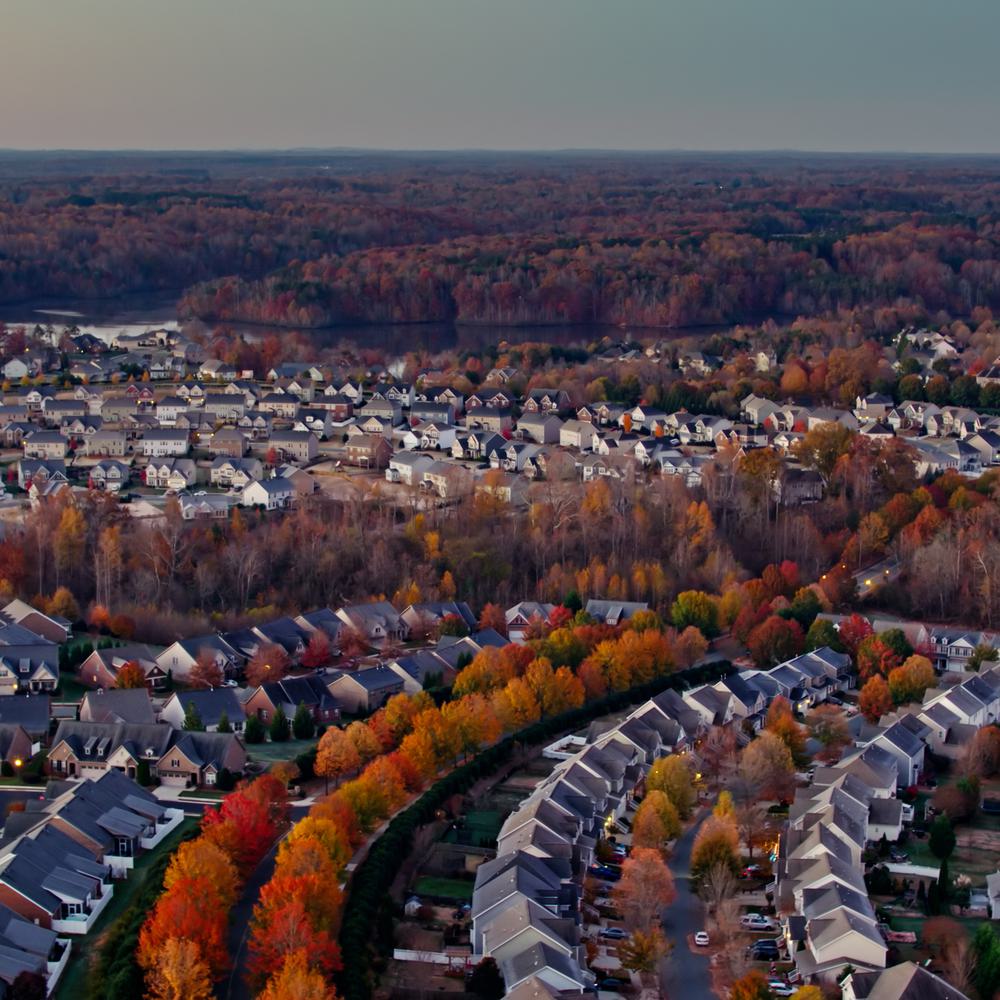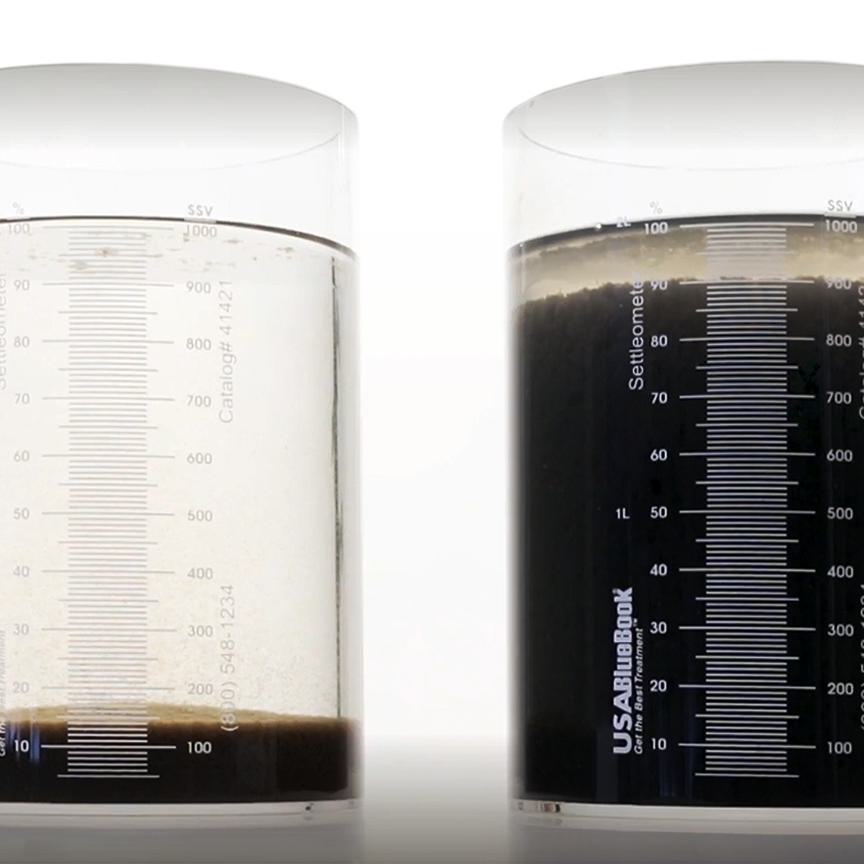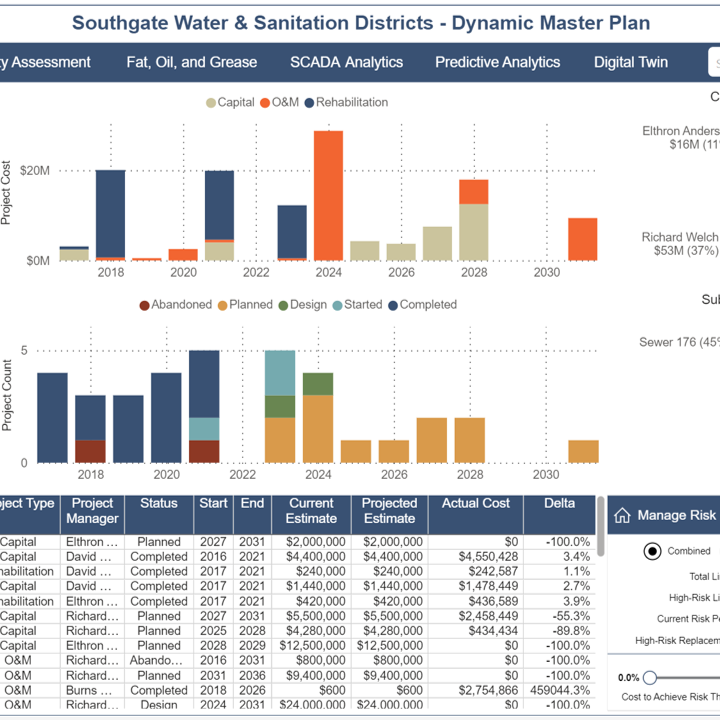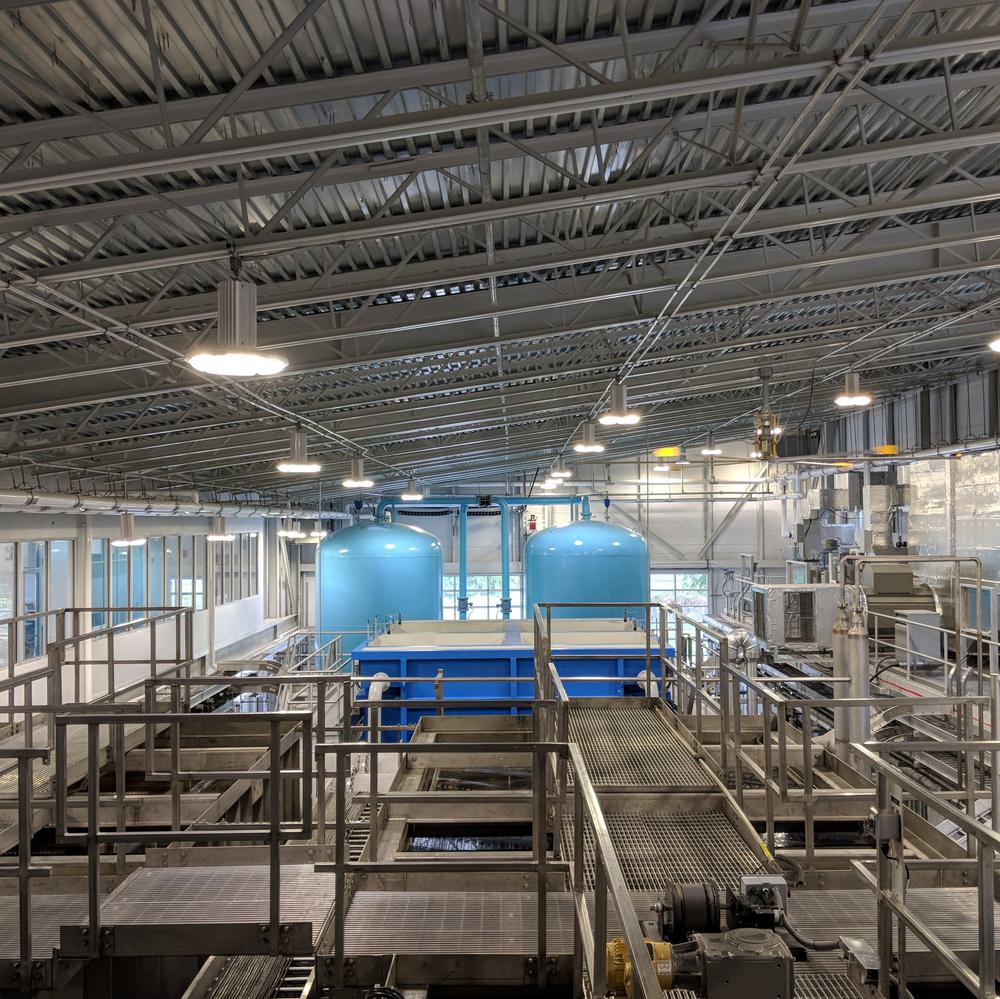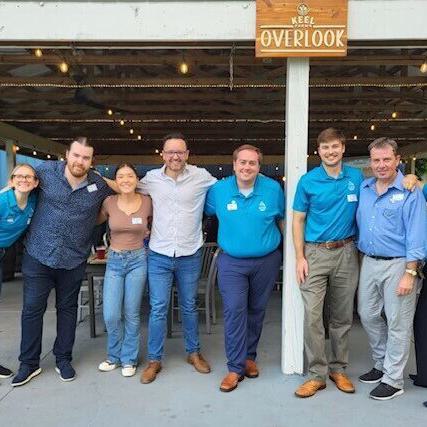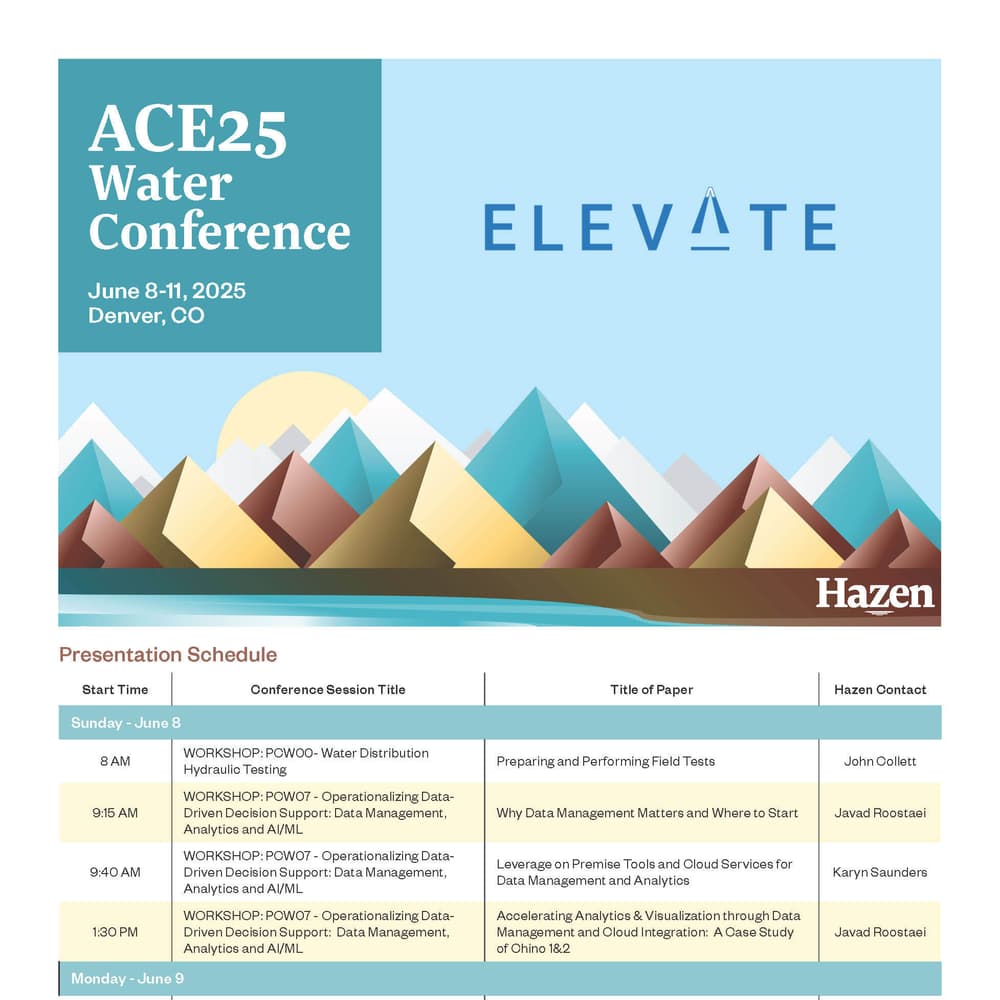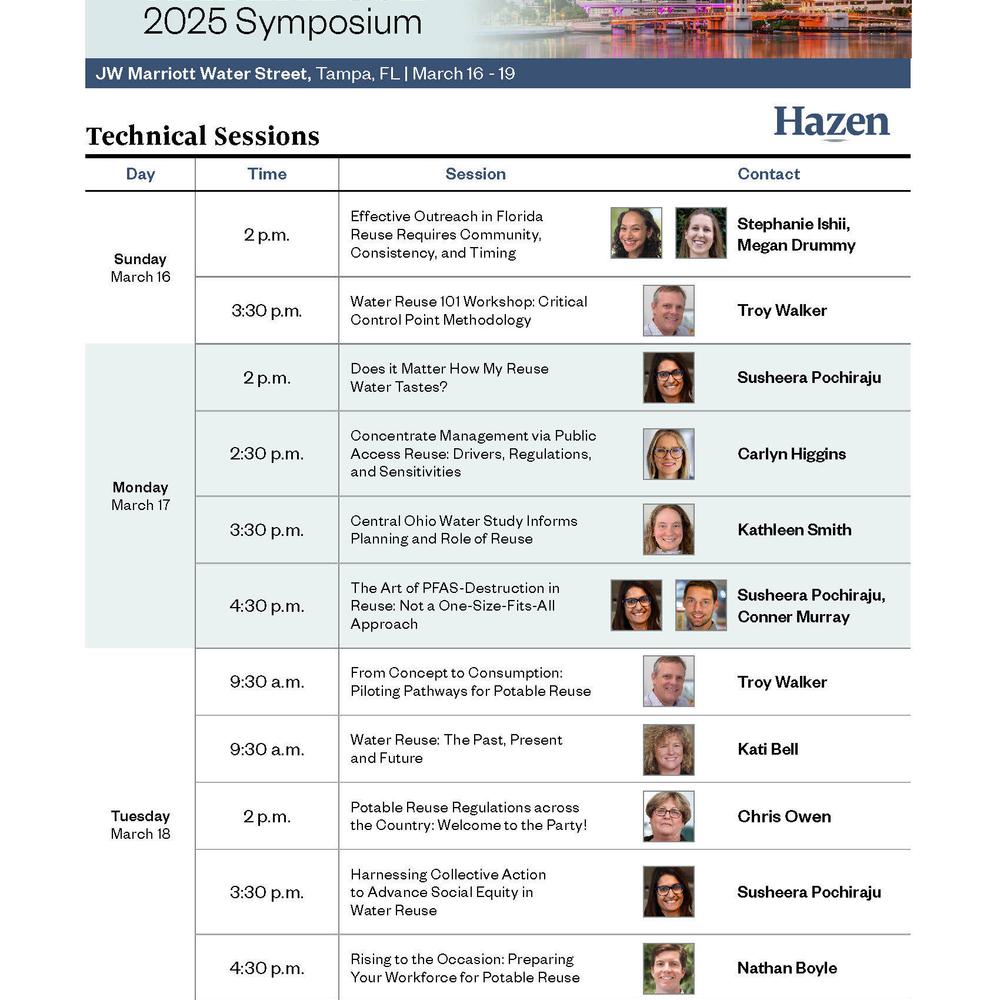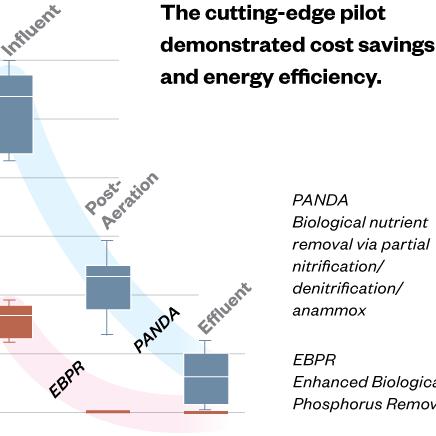Potable Reuse Is Coming to Your Region. Are You Ready?
Recycling wastewater for drinking water is usually associated with arid regions—but new water challenges are pushing it into the spotlight across the country.
Hollywood, Florida, probably doesn’t look like a place that’s hurting for water.
The beach city (pictured above) sits between Fort Lauderdale and Miami, with the Everglades in its backyard, the Atlantic at its doorstep, and some of the highest annual rainfall in a generally rainy state. The forecast often includes flash flood warnings and, during cold snaps, advisories about invasive iguanas dropping from the trees. It’s as tropical as a mainland city can get.
It might seem odd, then, that in 2013, Hazen spent 10 months helping Hollywood test a way to recycle wastewater.
The test system—a small-scale design called a pilot—used a process known as carbon-based advanced treatment (CBAT) to remove most pollutants, except some salts, from city wastewater. The team then tested whether the recycled water would be suitable to replenish the Floridan Aquifer, a reserve of salty groundwater widely tapped for drinking water. Drinking water plants that use its water remove the salts through a process called reverse osmosis, or RO.
“Recharging the Floridan had never been done before,” said Enrique Vadiveloo, an Associate Vice President at Hazen who led the project. “The pilot worked extremely well.”
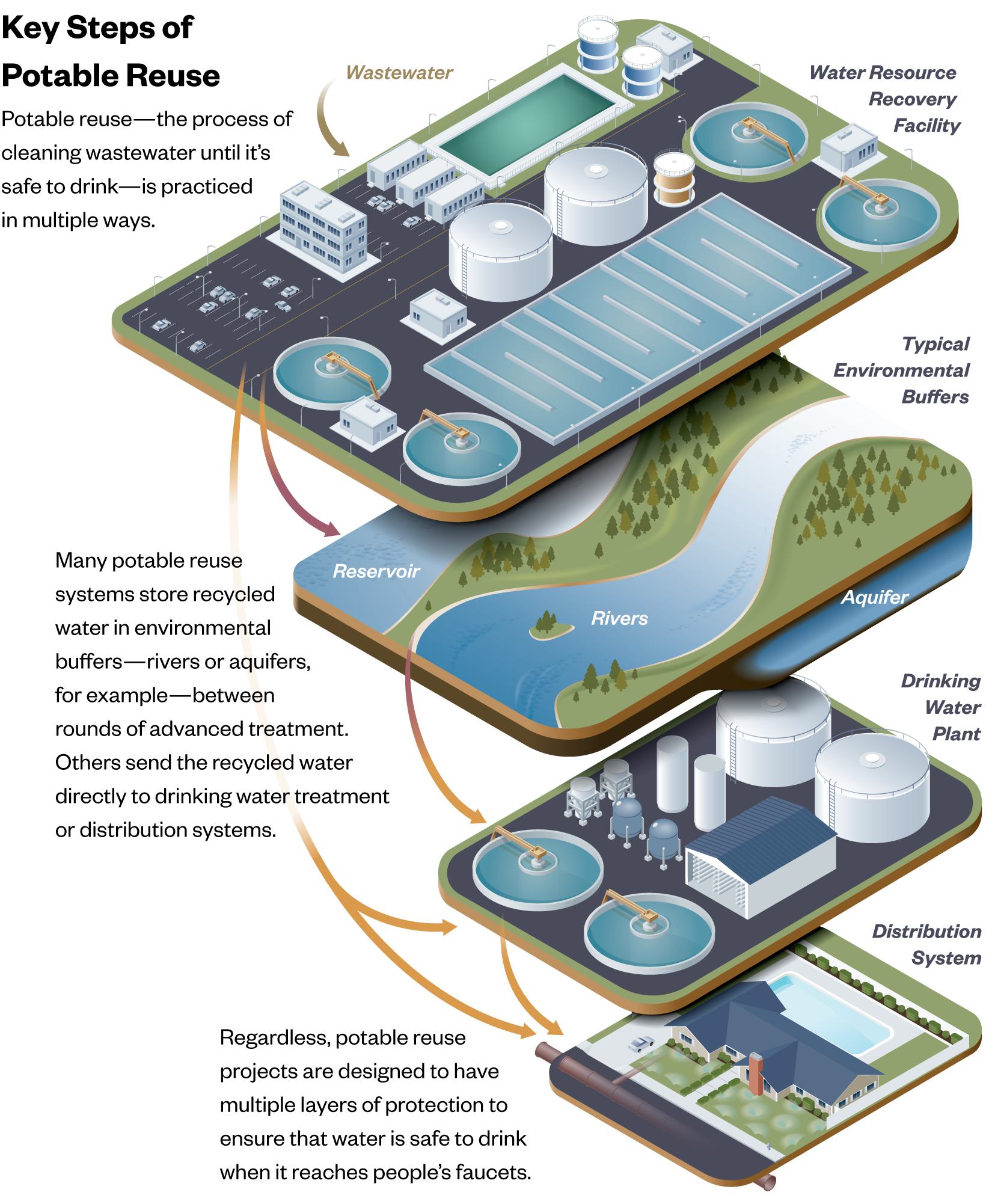
That whole scenario is a form of potable reuse: the practice of treating wastewater until it’s safe to drink. There are multiple ways to do it. Some systems send wastewater through advanced treatment, then straight to a drinking water plant or distribution network. Others, like the one Hollywood considered, use the recycled water to replenish groundwater, rivers, or reservoirs used for drinking water.
The general concept is gaining ground in Florida for multiple reasons, said Stephanie Ishii, who directs Hazen’s Integrated Resource Technologies group and lives in Tampa.
“Even though Florida is a wet state, most of our drinking water supply is sourced from groundwater, and the groundwater has long been showing signs of depletion,” Ishii said.
Per state law, Florida wastewater plants must stop discharging treated wastewater, or effluent, to coastal and other surface waters—and instead reuse much of it—by 2032. That’s partly to protect aquatic life from nutrient pollution and partly to expand water supplies. Southeastern Florida utilities like Hollywood have to make similar changes even sooner.
As the Hollywood pilot shows, potable reuse isn’t new to Hazen. Some of our experts have been designing such systems for decades. But the practice has reached a critical moment. Between 2000 and 2020, the number of potable reuse projects in the U.S. swelled from 11 to more than 50—a 355% increase—according to the National Alliance for Water Innovation. That doesn’t include projects in development.
Such projects used to be concentrated in arid states like Arizona and California. But today, thanks to a growing number of water challenges, potable reuse is gaining traction even in wetter states like Florida and Virginia. It’s becoming an increasingly valuable option for utilities across the country to consider. Here’s what’s important to understand about it.

Windhoek, the capital of the desert country of Namibia, has been turning wastewater into drinking water since the late 1960s.
Potable reuse isn't new.
Ask Troy Walker, who leads Hazen’s Water Reuse group, how long potable reuse has been in practice, and he’ll probably ask whether you mean the deliberate or the unplanned kind.
“Potable reuse has been happening for centuries—it just hasn’t been acknowledged,” said Walker, who has helped design reuse systems across the U.S. as well as Africa, Asia, and Australia. “If you live on any inland river system, you likely drink some blend of the effluent that’s coming from wastewater treatment plants in towns upstream of you.”
In the U.S., that effluent has been treated with increasing rigor since the adoption of the Clean Water Act. But it’s a common source of drinking water. One study found that effluent can account for as much as 50% of the raw water entering downstream drinking water plants, depending on the location and environmental conditions.
Planned potable reuse, Walker said, has been around for more than 50 years. He cited a slew of examples. Windhoek, the capital of Namibia, a desert country in southern Africa, pioneered a CBAT-based potable reuse system in 1968. That same decade, Los Angeles began sending recycled water into basins that let the water percolate down into a key aquifer. Fairfax County, in Northern Virginia, has used recycled water to support a drinking water reservoir for 40 years.
Timeline: Key Potable Reuse Projects in the U.S.
The list of successful projects keeps growing, and so has the body of research showing that recycled water—when it’s treated correctly—is safe to drink. Walker and others at Hazen have also pioneered the application of hazard analysis and critical control points (HACCPs), a rigorous method for ensuring food safety, to potable reuse systems. Simply put, there’s a lot of knowledge and research about how to run such systems well at this point.
“I get the initial hesitancy people have about it,” said Walker. “The first time you drink recycled water, the logical part of your brain is telling you how safe it is, and there’s another part thinking about where the water came from. But it’s been proven again and again. I brew my own beer with recycled water.”

A man crabbing on the Chesapeake Bay. Increasingly strict nutrient pollution limits for the Bay, and other sensitive receiving waters around the country, have led some wastewater facilities to consider recycling the wastewater.
The reasons for recycling water have multiplied.
Hollywood, Florida, decided not to build a full-scale CBAT groundwater replenishment system after the pilot due to uncertainty about potable reuse regulations the state was still hashing out at the time. But the following year, Enrique Vadiveloo found himself presenting the pilot results to another interested utility: Hampton Roads Sanitation District (HRSD), which serves 1.9 million people in coastal southeastern Virginia.
HRSD was beginning to develop what would eventually become the Sustainable Water Initiative for Tomorrow (SWIFT), an innovative, CBAT-based potable reuse system that Hazen helped HRSD design.
Jamie Heisig-Mitchell, HRSD’s Director of Water Quality, said it all started with pollutant regulations. Staff were expecting tighter nutrient limits for the Chesapeake Bay, where HRSD’s effluent ends up. They also knew they could soon face new limits for chemicals of emerging concern—substances thought to potentially pose health and environmental risks—and disease-causing pathogens like coliphage. Treating wastewater to drinking water standards seemed like a way to keep up with that “very dynamic regulatory environment,” Heisig-Mitchell said.
But as HRSD explored further, it learned that recycled water could also help recharge the Potomac Aquifer, a crucial and heavily depleted aquifer in the region. Recharging the aquifer could even reduce settling or sinking of the land surface and protect the groundwater from coastal saltwater intrusion—both of which can occur when aquifer levels dip too low.
“We’re at the point now where reuse is overwhelmingly important to consider for a whole variety of reasons,” said Hazen Water Practice Lead Erik Rosenfeldt, who worked extensively on the SWIFT Research Center’s design. “That’s why SWIFT happened.”
Rosenfeldt said that many parts of the country need to start considering reuse because they’re experiencing droughts or draining groundwater unsustainably. Even some regions with decent rainfall are starting to face water supply challenges because their populations are growing beyond what rivers and reservoirs can sustain.
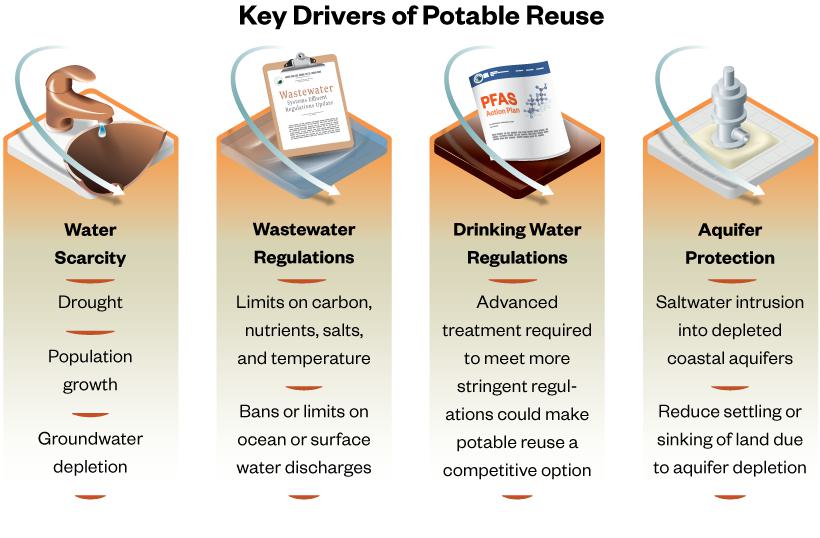
Meanwhile, the wastewater effluent regulations driving potable reuse will likely keep expanding, said Wendell Khunjar, Hazen’s Director of Wastewater Innovation.
“Nutrient limits are what I would call generation one regulations,” Khunjar said. “Generation two is emerging contaminants like PFAS. And I think generation three that’s coming in the future will include salts and even water temperature. Some places already have regulations for those things.”
Regulations are expanding on the drinking water side, too, to address everything from PFAS contamination to salt balances. As the cost of all that treatment climbs, Khunjar said, it makes sense for utilities to ask what HRSD asked: “Why not just take that extra step and reuse it?”
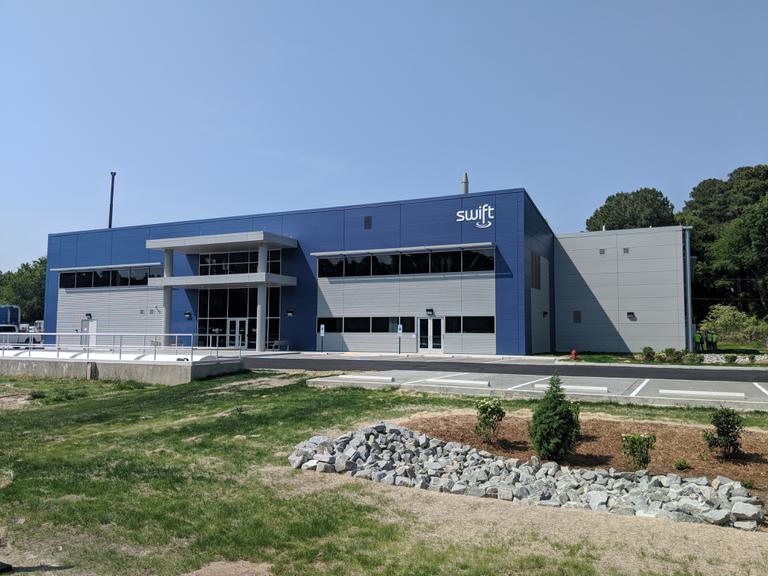
The SWIFT Research Center, in southwest Virginia, turns wastewater into drinkable water and uses it to replenish a key aquifer.

The Research Center's treatment system, viewed through one of the glass panels that allow members of the public to watch the treatment in action.
CBAT is unlocking the potential for potable reuse in places that couldn't previously consider it.
HRSD’s first SWIFT facility, a Hazen-designed demonstration facility called the SWIFT Research Center, opened in Suffolk, Virginia, in 2018. Beyond helping engineers and operators fine-tune the technology, the Center is open to the public. Anyone can come watch the plant’s CBAT system as it turns wastewater into drinkable water—a million gallons a day—and uses the water to replenish the Potomac Aquifer.
CBAT- and RO-based treatment systems are the main technologies for potable reuse, and in the U.S., the latter is often considered the go-to option. RO systems force water through membranes that separate out a wide range of contaminants. The membranes also remove salts, or total dissolved solids (TDS), making them attractive for potable reuse in the dry West and Southwest, where water tends to be saltier.
CBAT systems, in contrast, use filters made with a porous material called granular activated carbon (GAC). The traditional way to use GAC is to simply let water pass through the carbon granules, which trap dissolved contaminants against their exceptionally large surface areas. That method has been used for decades.
But more recently, utilities have begun growing beneficial bacteria and other microorganisms on the surfaces of the carbon to form what’s called biologically activated carbon (BAC). The microorganisms help eat up organic pollutants, and they’re especially effective when preceded by a disinfection process called ozonation. Today, CBAT systems typically involve ozone-BAC followed by standard GAC. The technique doesn’t remove salts, but its ability to remove other dissolved contaminants—including PFAS—has triggered a wave of new interest in CBAT.
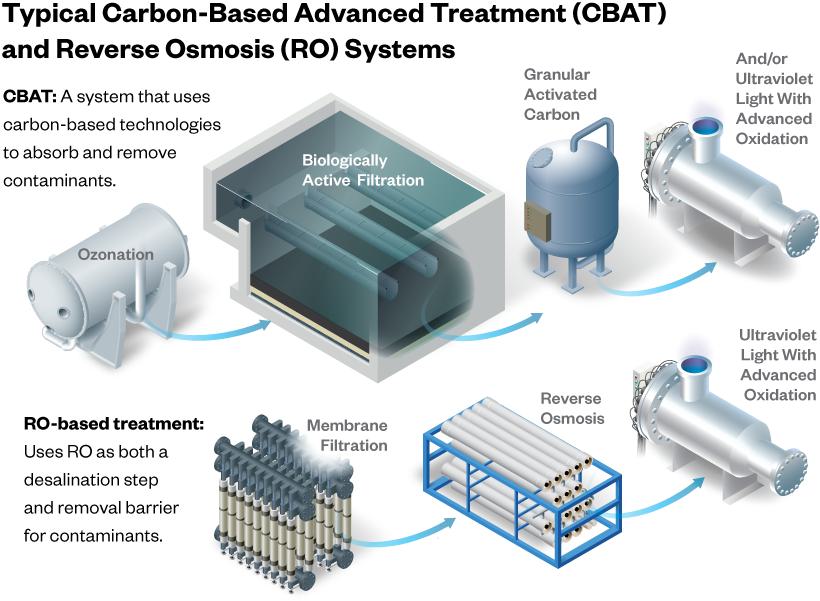
Heisig-Mitchell said HRSD picked CBAT partly for water chemistry reasons. When the utility tested RO, the technique removed too much salt from the water for it to be chemically compatible with the aquifer’s groundwater, which is a bit salty. A CBAT pilot was able to produce chemically suitable water.
RO-based systems also generate brine, a concentrated salt solution that contains everything removed from the water. It requires disposal, and HRSD didn’t have a good place to send it.
“In some parts of the country, you can discharge that brine into deep ocean waters or deep aquifers,” Heisig-Mitchell said. “But here on the East Coast, we really don’t have those deep waters nearby.”
CBAT doesn’t generate brine. And while it can’t address the growing problem of water salinity, it does unlock the potential for potable reuse in places that couldn’t previously consider it due to brine management challenges.
The right potable reuse system for any utility depends on its unique water quality, situation, and goals.
Rosenfeldt stressed that RO remains a highly effective option for potable reuse systems—sometimes the better option. It all depends. HRSD chose CBAT to meet needs specific to the Potomac Aquifer, Chesapeake Bay, and goals of SWIFT. For your own utility, he said, focus on where your water quality starts and where you need it to go.
“Are salts more your main issue? Maybe you need RO,” Rosenfeldt said. “Are you planning to send the water into an aquifer that has a very particular water chemistry? CBAT’s good for that kind of fine-tuning. It’s really about selecting the right technology for your utility’s needs.”

The Orange County Water District in Southern California uses reverse osmosis (RO) equipment, shown above, to help recycle water used to replenish groundwater.
In California, some utilities may even need a blend of both systems: The state is creating regulations for (what it calls) direct potable reuse systems that will require pairing the ozone-BAC process from CBAT with RO. The setup could be cost- and energy-intensive but also has multiple benefits, added Walker.
“The ozone-BAC adds another layer of pathogen removal and improves the quality of the RO-treated water,” Walker said. “It also does a tremendous job of removing and destroying some emerging contaminants. So that stuff is not going into the RO brine, which means fewer contaminants in the brine being discharged into the ocean.”
Evolving regulations like that are just one factor Hazen is tracking to help clients find potable reuse approaches that work for them. Like the Hollywood pilot and the SWIFT Research Center, the pilots we’re currently working on across the country—from California to Tennessee to Florida—reflect the site-specific needs and goals of each client.
“We don’t come in with a solution,” Walker said. “We identify a solution based on the situation.”
He added that recycled water isn’t the only solution to the water challenges today’s utilities face. Some cities may be able to tap into other alternative water supplies like stormwater, groundwater, and quarry lakes. And recycling water for non-potable uses like irrigation can free up more drinking water for the customers who actually drink it.
“But potable reuse is another arrow in our quiver, and an important one,” Walker said. “And with the right technology approach, it’s a tool that can be open to any utility.”
Considering potable reuse? Read a utility leader's tips on how to design a successful project here.






